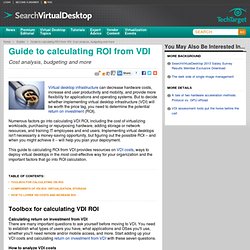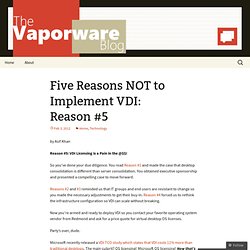

Guide to calculating ROI from VDI: Cost analysis, budgeting and more. Cost analysis, budgeting and more Virtual desktop infrastructure can decrease hardware costs, increase end user productivity and mobility, and provide more flexibility for applications and operating systems.

But to decide whether implementing virtual desktop infrastructure (VDI) will be worth the price tag, you need to determine the potential return on investment (ROI). Numerous factors go into calculating VDI ROI, including the cost of virtualizing workloads, purchasing or repurposing hardware, adding storage or network resources, and training IT employees and end users. Implementing virtual desktops isn't necessarily a money-saving opportunity, but figuring out the possible ROI -- and when you might achieve it -- will help you plan your deployment. This guide to calculating ROI from VDI provides resources on VDI costs, ways to deploy virtual desktops in the most cost-effective way for your organization and the important factors that go into ROI calculation.
Five Reasons NOT to Implement VDI: Reason #5. By Asif Khan Reason #5: VDI Licensing is a Pain in the @$$!

So you’ve done your due diligence. You read Reason #1 and made the case that desktop consolidation is different than server consolidation. You obtained executive sponsorship and presented a compelling case to move forward. Reasons #2 and #3 reminded us that IT groups and end users are resistant to change so you made the necessary adjustments to get their buy-in. Now you’re armed and ready to deploy VDI so you contact your favorite operating system vendor from Redmond and ask for a price quote for virtual desktop OS licenses. Party’s over, dude. VDI Economics and Reality. If you would like to be notified of when Scott Lowe releases the next part in this article series please sign up to our VirtualizationAdmin.com Real Time Article Update newsletter.

Introduction On the surface, Virtual Desktop Infrastructure (VDI) is a wonderful thing. There are promises galore out there with regard to how much money you’ll save and all of the other benefits around it. But, there are some cold, hard truths that must be confronted before jumping into the fray. You will not immediately save money with what’s being sold as VDI today. Now, when we’re talking about long-term TCO, things might look a little different, but it largely depends on your goals, the current state of your desktop management solution and your willingness to differentiate users with different needs and provide computing solutions based on those differing needs. Let’s start by talking about a recent study performed by Microsoft, which had some interesting results regarding VDI.
How can this be? The hidden costs of VDI. By Brian Madden Last week I gave a breakout session at Citrix Synergy’s Virtualization Congress called "The REAL cost of VDI.

" This was not about the cost of losing your job if you built a bad VDI environment; rather, it was about the hidden costs of VDI that many people don’t consider until they’re like, “Oh shit” during the middle of their deployments. Before we jump into this, I want to point out once again that I like VDI where it makes sense. (Watch this video of me presenting “TS versus VDI” to understand where each makes most sense.) I should also point out that for this entire article, I’m talking about the VDI flavor of desktop virtualization, which is server-based computing with users connecting to single-user VMs running in a datacenter. A quick note about cost models The purpose of this article is to discuss some of the unexpected expenses that crop up in VDI projects.
Let’s first take a look at the hidden costs that we find in all flavors of server-based computing. Microsoft TCO study: VDI is 11% more expensive than traditional PCs. One reason? Increased costs of Microsoft licensing! By Brian Madden Yesterday I learned about a study that Microsoft released (PDF) that compared the TCO of VDI versus traditional desktops.

Their analysis was that with Windows XP SP3, VDI was 9% more expensive overall, and with Windows 7 VDI was 11% more expensive. Now of course it's well known that I believe it's easy to manipulate TCO numbers to show whatever you want (see How to lie with cost models, Dec 2009), so what's really interesting about this study is not that VDI is higher, but that it validates that Microsoft prefers a world of traditional desktops instead of VDI.
(Although was anyone really questioning whether that was true? I mean if Microsoft really wanted VDI to take off, would VECD, VDA, and MDOP exist?) Also interesting was that Microsoft's study confirmed that the money saved on thin clients was more than enough to offset the additional server, storage and networking costs. In all seriousness, this Microsoft study is really, really good. InShare1.